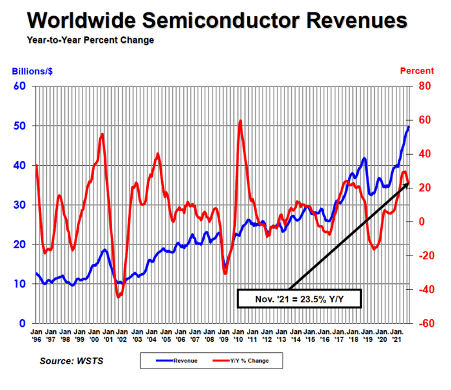Booming semiconductor sector enjoys record FY21 annual sales, but there’s a problem on the horizon

More skilled workers are needed to keep up with chip demand as companies expand their fabrication footprints. Pic via Getty Images
The Semiconductor Industry Association (SIA) recorded bumper global industry sales of $49.7 billion in November 2021 – that’s an increase of 23.5% from November 2020.
It’s also 1.5% more than October 2021.
Semiconductors are the ‘brain’ of electronics, used in the fabrication of smartphones, digital cameras, TVs, washing machines, refrigerators, cars – almost everything you use in day-to-day life.
SIA said the cumulative annual total of semiconductors sold through November 2021 reached 1.05 trillion, which is the industry’s highest-ever annual total.
The monthly sales are compiled by the World Semiconductor Trade Statistics (WSTS) organisation and represent a three-month moving average.

New annual record for semiconductor sales
“Global semiconductor sales remained strong in November, increasing substantially on a year-to-year basis across all major regional markets and semiconductor product categories,” SIA president and CEO John Neuffer, SIA said.
“With one month of 2021 sales data still to be reported, the industry has already set a new annual record for total semiconductor sales and units shipped, as chipmakers have substantially ramped up production to address high demand.”
In the Americas alone year-to-year sales increased 28.7%.
In Europe they increased by 26.3%, in Asia Pacific by 22.2%, in China by 21.4% and Japan 19.5%.
But there’s a labour shortage spanner in the works
SIA says the semiconductor industry directly employs over a quarter of a million workers in the United States.
But there’s not enough skilled workers to keep up with chip demand as companies expand their fabrication footprints.
Shortages of chips. Shortages of the machines that make the chips. Shortages of the people who make the chips and who make the machines that make the chips.https://t.co/tgZpNDVf0b pic.twitter.com/OmHbgsXnJf
— Eric Jhonsa (@EricJhonsa) January 4, 2022
According to the Wall Street Journal, the industry is facing a labour shortage, with both Intel and ASML flagging the need for more talent around the world.
ASML executive vice president Jim Koonmen told the Journal the industry is currently “in a war for talent.”
Talent management company Eightfold.ai reported that in the U.S. alone, around 70,000 to 90,000 workers or more will have to be added by 2025 from 2020 levels to meet the most critical workforce needs for anticipated fab expansion.
And while China has nearly doubled its labour force in the last five years, it was short about 250,000 engineers in 2020 – according to research firm EqualOcean.
UNLOCK INSIGHTS
Discover the untold stories of emerging ASX stocks.
Daily news and expert analysis, it's free to subscribe.
By proceeding, you confirm you understand that we handle personal information in accordance with our Privacy Policy.








